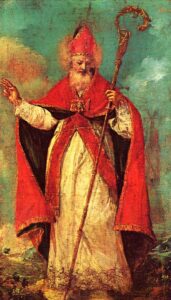
Saint Nicholas to Santa Claus: Where did the modern Santa come from?
There is something incredibly joyful about seeing children become excited about Christmas. Undoubtedly, the mere sight of Santa can bring sheer joy and delight to a child’s heart. Once, when my family and I were visiting a Christmas light display, I witnessed a kid lose all sense of control and enthusiastically jump up and down at the mere sight of the big man in red. “Santa! Santa! Santa!” The little boy yelled as he nearly dislocated his mom’s arm by dragging her to his beloved superstar.
While I loved seeing this little boy’s excitement and over-the-top reaction, I could not help but feel that the jolly man in red had stolen something from the person for whom Christmas is supposed to be celebrated. Did Santa replace Jesus? Believe it or not, Santa Claus would be mortified to learn that he had replaced the central figure of Christmas.
I know some of you may be scratching your heads right now, wondering what I am talking about. After all, Santa Claus is a fictitious character, right? Wrong. “Jolly Ol’ Saint Nick” was, in fact, a real person. He was a faithful bishop of the Church! St. Nicholas was the 4th-century Bishop of Myra (a city located in modern-day Turkey) who was beloved for showing God’s great love for children and the poor. Not only was he known for his charity, but he was an advocate for the Gospel as one who defended the true Faith at the council of Nicaea (The same council from which we received our Nicene Creed). We celebrate his life and ministry on December 6th. However, over the years, his feast day has shifted to merge with the celebration of Jesus’ birth on December 25th. On top of that, his legacy has been replaced by the mythology of elves, toys, and the North Pole. So how exactly did the hero of the Faith, Saint Nicholas, turn into the famous commercialized Santa Claus we know today?
of Nicaea (The same council from which we received our Nicene Creed). We celebrate his life and ministry on December 6th. However, over the years, his feast day has shifted to merge with the celebration of Jesus’ birth on December 25th. On top of that, his legacy has been replaced by the mythology of elves, toys, and the North Pole. So how exactly did the hero of the Faith, Saint Nicholas, turn into the famous commercialized Santa Claus we know today?
St. Nicholas became an important saint in Holland. When the Dutch settled in New York in the 1700s, they introduced “Sinter Klass” (later translated into English as “Santa Claus”) to broader Western culture. Sinter Klass was depicted as a tall, thin, stately bishop wearing the vestments of the church, including a cope (a beautiful cape), mitre (a large pointy hat), and crozier (a shepherd’s staff).
This image would later evolve in the 19th and 20th centuries. The author, Washington Irving, and poet, Clement Moore, did much to change the appearance and character of Saint Nicholas. Irving’s books, History of New York and Old Christmas, transformed St. Nicholas’s mitre into a floppy stocking cap, and cope into a red jacket. Moore changed the popular imagination even more in 1823 with his famous words: “’Twas the night before Christmas…” This poem, written for the poet’s children, further embellished Irving’s images and effectually moved the visitation of St. Nicholas from his feast day on December 6th to Christmas Eve.
The result was that Saint Nicholas was removed from his origins as a generous model for Christian giving and Gospel proclamation. This led to confusion regarding why gifts are given at Christmastide in the first place. Saint Nicholas was known for giving money and gifts to poor families and children in the name of Christ. The tradition of giving gifts on December 6th was meant to celebrate his charity and remind us that faith is not merely intellectual assent but is expressed through acts of love, mercy, and charity. In America, however, gifts are lavished upon children without any hint of explanation.
How should Christians respond? Some argue that we ought to throw the Saint out completely. I knew such a priest in Tallahassee. He told his children that Santa Claus was not real and that he distracted us from the real meaning of Christmas. What was the result? His children told their Sunday class which led to a massive uproar from the other parents. This “solution” also disparages a faithful member of the body of Christ over false accusations.
I place the burden on us as parents and role models in the Church to teach our children the heart of Christmas, which is the free love of God through Jesus. The Santa of our culture celebrates gifts given to “good” children; that is, children learn to earn their presents. In contrast, the love of God cannot be “earned” — it is a true gift. Santa gives whatever we ask. Jesus gives us his life to bring us closer to God. Santa gives us stuff we quickly forget about. Jesus gives us eternal spiritual transformation. Santa distracts us from the real meaning of Christ. On the other hand, the real Saint Nicholas would point us toward the true gift of Jesus.
I am not saying that Christian parents should not allow their children to enjoy the fun of Santa Claus. What I am suggesting is that we reorient the story of St. Nicholas to recapture the heart of the Saint. If you celebrate Santa, make certain your children see him as a bishop of the Church who loves God so much that on Jesus’ birthday, he gives gifts to everyone to demonstrate the love of God. As the Church, we must work hard to keep Christ at the center of this celebration.
How wonderful it would be if our children’s eyes would light up not just when they hear, “’T’was the night before Christmas… ,” but also when they hear, “For unto you is born this day in the city of David a Savior, who is Christ the Lord…”

